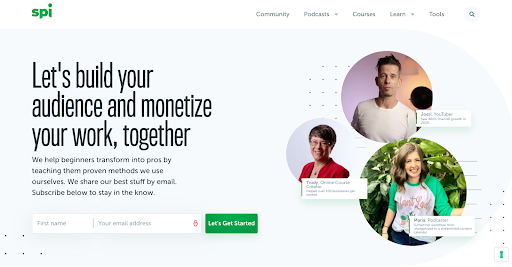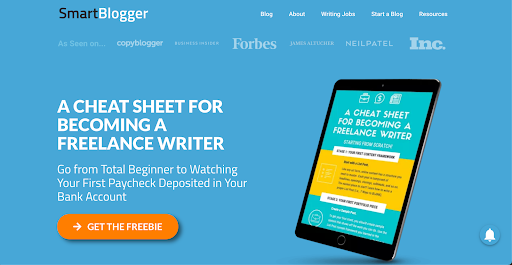You might have previously heard the terms organic email list and non-organic email list used when talking about email marketing. While most email marketing advice out there is focused on organic list building, there are still businesses that rely on the non-organic way.
So, what do these terms mean, and what is the difference between the two strategies? We’ll explain organic vs. non-organic email lists ahead.
What is organic email list building?
Organic email list building is an email marketing strategy when you’re building your email list from scratch using organic methods.
The process is usually simple: You create a lead magnet or incentive, build a landing page to collect new sign-ups, and then onboard people into your email list. People on your organic email list are there because they found you and decided to sign up themselves.
A great example is an online entrepreneur and course creator, Pat Flynn. When you visit his website, the first thing you see is the invitation to sign up to his email list:

Sometimes, the incentive is more obvious than a simple invitation to sign up for a newsletter that will bring you value. Some entrepreneurs opt for offering solid lead magnets like PDFs, ebooks, email courses, etc. A good example is the Smart Blogger and the Cheat Sheet they offer in exchange for people’s emails:

The pros and cons
Pros:
- Higher-value leads: People on your organic email list signed up for it, so they know who you are and what you can offer them. They are already interested in your business, and that makes them more valuable than bought leads.
- Better deliverability: The chances of you landing in their “Spam” folder are smaller with the organic leads because they go through the double opt-in process and safelist your email address to receive your newsletters.
- Higher open rates: The success of your email list depends on how engaged your list is. Organic leads have higher open rates, which will lead to a more engaged and healthy list.
Cons:
- Slower growth: Building your email list organically takes time and effort. You’re going to have to create landing pages, freebies, write onboarding emails, and promote your sign-ups everywhere yourself, which is harder than buying a list.
What is non-organic email building?
Non-organic email list building is a marketing strategy when you use special services to purchase email lists instead of capturing them yourself.
Companies scrape available emails online and gather them into databases that are later sold to businesses looking to build their email lists. The emails on those lists are from all over the place, and there is no guarantee that what you’re buying will be your target audience.
So, with the non-organic email list building, you’re skipping the lead capturing yourself, instead opting for someone else to do that work for you.
The pros and cons
Pros:
- Faster growth: With one click, you can go from 0 subscribers to 10,000 subscribers in a day.
- Less work on your brand: By buying the leads, you save the time you’d spend on building your brand to attract people to your email list.
Cons:
- More work to engage the leads: Because people didn’t sign up to be on your list, it’s going to take a lot of effort to convince them to engage with you and stay on your list.
- Expensive: Buying an email list is expensive and might not be accessible for smaller entrepreneurs with limited marketing budgets.
- Low open rates: Because people on the non-organic list are not always your target audience, they might not even open your emails. Which means lower open rates and a less engaged list overall.
{{threesteps-component="/blog-shortcodes/blog-popup"}}
Growing an engaged list
Offer a valuable incentive
The easiest way to grow your organic email list is to offer a freebie or a lead magnet of value to people as an incentive to sign up for your email list.
This could be anything from ebooks, PDF files, quick guides, email courses, workbooks, access to part of your course for a limited time, etc. Just make sure it’s good quality and value to your prospective students.
Don’t skip on the welcoming sequence
The welcoming sequence will be the most important part of your email campaign. It’s the thing that will introduce your new subscribers to your business and tell them what they can expect from you.
So, take the time to set it up in a way that lets you automatically onboard new subscribers, welcome them, and streamline them into your regular email list.
Include your sign-up forms everywhere
How are people going to know you have an email list if you don’t tell them?
Include your email list sign-ups everywhere around your website, in your blog, in every blog post you write. If you have a podcast, mention it every episode and link to the sign-up in the show notes. Add the link to your social media profiles and even in your email signature.
Make signing up to your email list accessible to people.
Make it easy to sign up
When creating your sign-up form, make it short and sweet. Asking for the name and an email is enough. You don’t need to ask people for their surnames, address, and other personal information to join your email list.
The shorter the sign-up process, the bigger the chances that they’ll sign up.
Be honest about your policy
Make it clear to people what kind of emails they will get, how they can unsubscribe, and your privacy policy right off the bat. This will show prospective students that you’re honest, and they can trust you from the very beginning.
Make sure that you’re not spamming
If you want to keep people on your list, you have to give them exactly what they signed up for. Always make sure the content you’re sending is valuable, actionable, and useful for your subscribers.
The same goes for the frequency of your emails. Send emails weekly or bi-weekly, and avoid appearing spammy by emailing your list daily. Reserve more frequent, daily emails when you have a sale week or a new product launch.
Eliminate inactive subscribers
You have a reputation to build with email service providers, and the engagement of your list is a fairly important metric they track. If you have a large list that’s not very engaging, that damages your reputation.
So, every six months, do a purge where you eliminate inactive subscribers from your list to keep your email list and reputation with email service providers healthy.
Now that you understand the difference between organic vs. non-organic email lists, the choice is yours how you build your list.
Join more than 150,000 creators who use Teachable to make a real impact and earn a real income.


.png)
.png)



